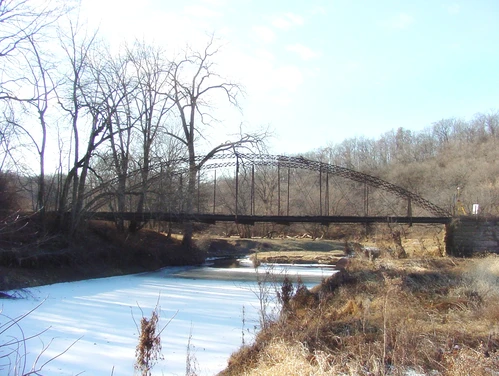- Year constructed: 1877-1878
- Alternate name: Lytle Creek Bridge
- Bridge type: Bowstring Through Arch-Truss
- National Register of Historic Places status: Listed
- Length: 114 feet
- Width: 13.8 feet
- Spans: 1
- FHWA: 145870
- Jurisdiction: Dubuque County
- Location: Creek Branch Lane over Lytle Creek, 2.5 miles southeast of Bernard, Section 31, T87N-R2E (Washington Township)
Details
The Dubuque County Board of Supervisors first contracted for a timber bridge over Lytle Creek, next to the Washington Mill, in 1865. That August the board hired local contractors Ambrose and Joel Higgins to build a small-scale timber stringer structure for this crossing in Washington Township, along with a bridge at Higgins Ford, for $295. Predictably short-lived, the first Washington Mill Bridge required frequent repairs to keep it serviceable. It was rebuilt in 1873 and again in 1876. Finally, in the fall of 1877 the board "ordered that a bridge be built at Washington Mill in Washington Township." The proposed new span would feature an all-iron superstructure in the hopes of eliminating the maintenance problems of its predecessors. In October the supervisors hired local mason T.J. Donahue to build new stone abutments for $765. At that time they contracted with the Massillon Bridge Company of Ohio to design, fabricate and erect a 113-foot bowstring arch-truss span for $1,824. Donahue began work on the substructure immediately, completing the massive abutments by January. Massillon fabricated the arch-truss using its standard, latticed double-plate design, completing the bridge in April 1878. The Washington Mill Bridge proved only slightly more durable than the structures it replaced; it required repairs in at least 17 of its 32 years of service. Nevertheless, the bridge has continued to function in place, with only maintenance-related alterations. Once on a main road through the southern part of Dubuque County, it now services a single farm.
The bowstring arch-truss was the iron span of choice for Iowa counties in the late 1860s and 1870s. Marketed extensively by such Ohio-based industry giants as the Wrought Iron Bridge Company, the King Iron Bridge Company and the Massillon Bridge Company, these often-patented bridge forms featured a wide range of span lengths, economical fabrication cost and relatively quick erection. The proliferation of the bowstring coincided with the initial development of Iowa's road system, and as a result, perhaps thousands of these prototypical iron spans were erected throughout the state. The bowstring design had some rather severe structural flaws, however, and it was superseded by the pin-connected truss in the early 1880s. Through subsequent attrition, almost all of Iowa's bowstrings have since been replaced and demolished. The Washington Mill Bridge is distinguished among those that remain by its pristine state of preservation. One of the oldest originally placed roadway bridges in the state, it is an outstanding early transportation-related resource.
Adapted from Fraser 1992
Areas Served
- Dubuque
